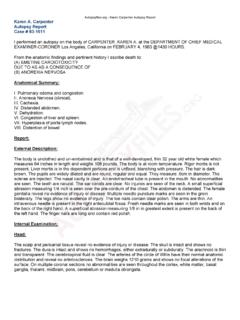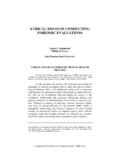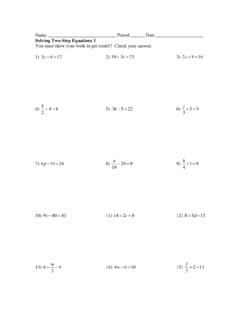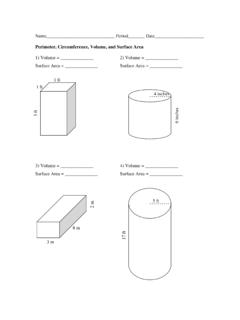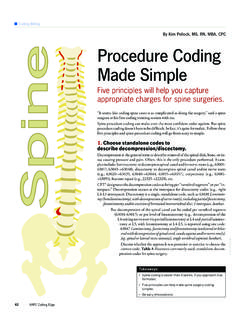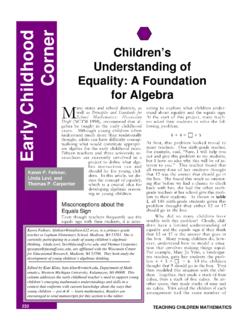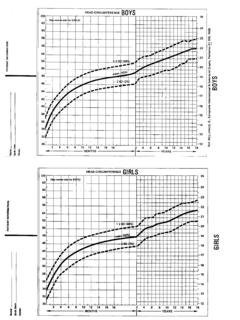Transcription of by Karen Walker Helping infants and toddlers …
1 Texas Child Care quarTerly / winTer 2016 / VOluMe 40, nO. 3 / response to the tragedy of 9/11, Fred Rogers shared this wisdom. I m convinced that when we help our children find healthy ways of dealing with their feelings in ways that don t hurt them or anyone else, we re Helping to make our world a safer, better place. What is your long-term goal for children in deal-ing with their feelings? I ll bet your answer has something to do with children being able to manage their own behavior, which we call self-regulation. What is self-regulation?Self-regulation, the ability to manage one s own behavior, refers to a range of characteristics and abil-ities. Young children who have self-regulation skills can control their emotions, focus their attention, and manage their thoughts, behaviors, and feelings. It s the ability to control impulses. Children who can self-regulate can stop a behav-ior, even if they want to continue, or start a behavior, even if they don t want to (Bodrova and Leong 2007).
2 This skill is not to be confused with obedi-ence. Even if no one is watching, a self-regulated child will behave appropriately. Many adults not only manage their behavior but also do well at performing more than one task at a time. An adult can fold laundry, talk to a friend on the phone, and think about what time to start dinner all at the same time, for example. But children who go into the playroom to pick up their toys might get distracted by their favorite toy and not clean up the room at all. Furthermore, an adult can sit through a long, boring meeting and still smile and participate in a productive way when needed. But if young children are asked to sit through a long lesson, they may fidget, run around, and fuss or start to cry. Young children tend to live from moment to moment and are ruled by impulses and feelings. By comparison, many adults can filter out distractions, exercise self-control, and decide what is an appropriate reaction before they speak or act.
3 As early care and education professionals, we need to understand self-regulation to be able to rec-ognize, encourage, and help children develop this important skill. Why is self-regulation important?Self-regulation is an important skill for success in school and in life. In 2013, Sesame Street released a new segment called Cookie s Crumbly Pictures, a col-lection of spoof movie trailers to help Cookie Monster learn how to control his insatiable appetite for cookies. In The Biscotti Kid parody, Cookie learns Biscotti Karate must keep eyes on (binocu-lars around eyes), ears listen (point to ears), mouth quiet (finger to lips), and body calm (belly breathe) in order to earn his cookie belt. According to the website, learning to self-regulate is phOTO by susan gaeTzfeature by Karen WalkerHelping infants and toddlers learn self-regulation Texas Child Care quarTerly / winTer 2016 / VOluMe 40, nO. 3 / children need to start becoming thoughtful, patient people (Mustich 2013).
4 In their 2003 study, Lin, Lawrence, and Gorrell found that on a scale of very important or essential, kindergarten teachers placed the skills of Is not dis-ruptive at percent and Tells needs/thoughts at percent. By comparison, the skills of Counts to 20 or more and Knows most of the alphabet were rated percent and percent. Clearly kindergarten teachers view self-regulation skills as fundamental for school readiness. But wait-ing to foster these skills until a child is 4 or 5 years old may be too late. Through caring, nurturing rela-tionships, even infants and toddlers can learn to take control of both their thinking and their feelings (Bodrova and Leong 2007). Self-regulation in infantsInfants depend on caring, responsive adults to meet all their needs. They cry to let caregivers know they need to be fed and changed, but also when they need to be played with or put down for a nap. The ability to self-soothe, a term used with infants , is less about an adult s caregiving and more about an infant s temperament.
5 In 1956, Stella Chess and Alexander Thomas began a cross-cultural, longitudi-nal study defining the characteristics of tempera-ment the way someone responds to people and objects. Three patterns emerged: easy, slow-to-warm-up, and difficult (Thomas and Chess 1977). When describing these patterns in infants , a caregiver might say, Jenny sleeps, eats, and has a bowel movement just like clockwork. I never know when D andre will be hungry or sleepy. As long as we have a predictable schedule, Luciana is just fine. An attentive caregiver will notice children s behaviors, value differences in temperament, and accept indi-vidual personality differences. Even slow-to-warm-up and difficult infants come into the world with some capability to self-soothe. They suck their fingers or thumbs, turn away from loud noises or bright lights, ball their hands into fists, and yawn. These are signals that infants use to show that their central nervous system is full. They are communicating that stress is setting in, and care-givers need to intervene with gentle touch and gen-tle talk.
6 Parentese, that sing-song voice with elongat-ed consonants and vowels when an adult talks to an infant in an exaggerated and repetitive way can calm a child and teach language skills. Touch and voice can be powerful tools to help infants in distress. Singing, cradling, caressing, and patting can help. Swaddling or cozily wrapping a cranky newborn can be an effective technique, as their arms are brought to midline. Older infants may be happier with their arms and hands at midline, but tight swaddling may not be helpful. Loud noises, bright lights, and strong smells can overstimulate infants . We need to be aware of the environment and adjust to suit children. Self-regulation in toddlersToddlers can participate in their own self-regulation. During moments of moderate stress, in a familiar environment, children can practice self-regulation. One example is waiting when they are a little hun-gry, knowing that they will soon have a snack or lunch. Once they master their body s stress signals, they become better able to handle other stressful sit-uations (Florez 2011).
7 toddlers Can parTiCipaTe in Their by susan gaeTz Texas Child Care quarTerly / winTer 2016 / VOluMe 40, nO. 3 / The toddler years are a time when structured and predicable daily routines and schedules support their self-regulation. Dimming the lights and turning on soft music let children know it is time to rest. After rest time, we will get up for a story or play outside. A consistent schedule helps children learn what to expect throughout the day. The toddler years can also be the most challeng-ing, especially when adults expect too much out of children who are just learning to walk, talk, and remember. Remembering, like walking and talking, is a skill that develops. None of us remembers being born, thank goodness! As children learn to walk and talk, they also develop the ability to remember. Working memory governs our ability to retain information long enough to follow through with instructions. (Recall the child sent to clean the play-room and Cookie Monster working for his karate belt.)
8 In the toddler years it will be hit and miss when it comes to the ability to stop, think, and make a choice before acting. Young children need several opportunities to practice and gentle reminders before they can be expected to master self-regulation. toddlers respond well to sensory activities in which they can see, touch, move, hear, smell, and even taste. Dancing, climbing, painting, singing, and generally exploring are happy activities for toddlers . Sitting, listening, and observing are just too passive. toddlers engage the world with all five senses and then fall asleep in a plate full of spaghetti. Fortunately, these mysterious creatures learn by watching and imitating the caring, responsive adults in their lives. Watch for opportunities to model self-regulation by sharing your private-speech. Can you smell the delicious peach cobbler chef is baking for lunch? I can t wait to taste it! Tomorrow the therapy dogs will visit our school. What will that be like?
9 Some children love surprises, but most do better when they have some idea what to expect. Transition activities, those quick games or songs, help with waiting and schedule changes. Too many starts and stops, however, can be frus-trating and confusing. If you are having a special guest or event, prepare children and practice expect-ed behavior. For example, before a musician brings a guitar to play in your class, remind children that they will get a chance to strum the strings one at a time. the important role of responsive adults Just as you would help an older child learn to recog-nize their name or snip with scissors, you can help infants and toddlers learn self-regulation skills. Three strategies can be useful modeling, scaffold-ing, and nudging. Modeling Show children appro-priate behavior and how to achieve it. Notice and comment when children display the behaviors you want them to develop. Scaffolding Recognize what they can do successfully, support them as they learn to manage their thoughts, behaviors and feelings, and gradually remove adult assistance.
10 Nudging Provide cues to nudge infants and toddlers as they learn to focus their attention and control their emo-tions. Eye contact, raised eyebrows, a touch on the shoulder, or a consistent word or phrase might be the hint the child needs to begin to self-regulate (Florez 2011). The toddler years Can be TheMOsT by susan gaeTz Texas Child Care quarTerly / winTer 2016 / VOluMe 40, nO. 3 / , responsive caregivers are keySelf-regulation means the ability to control impulsive behaviors and emotions. It s a critical skill that can bring success in school and in life. Kindergarten may be too late for children to start learning this skill. Caring, responsive caregivers can nurture self-regulation beginning in infancy and the toddler years in many ways, such as by recognizing stress signals, setting consistent routines, letting chil-dren know what to expect, and giving gentle reminders. referencesBodrova, E., and D. J. Leong. 2007. Tools of the Mind: The Vygotskian Approach to Early Childhood Education (2nd Ed.)
